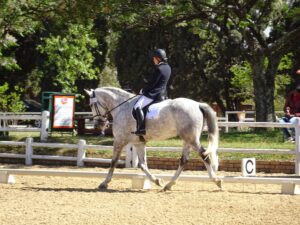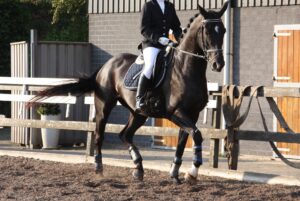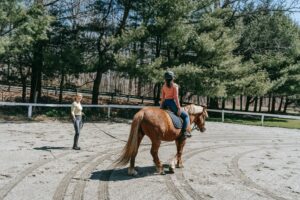When I watch dressage, I frequently notice riders leaning back and sitting quite behind the vertical, despite the fact that when I look at old pictures, the riders were sitting correctly, says Christopher Hector – an interviewer of Christoph Hess.
Christoph Hess comments that riders need to understand that they must move with the horse with their upper bodies, not behind. Many riders, in my opinion, believe that they have greater influence and opportunities to use their weight when they are seated behind. However, I agree with you that this is not the proper approach to go. You must follow the motion and give the horse room to elevate its back.
Rising trot VS Sitting trot
The brightest eventing riders, in the opinion of Christoph, can educate many dressage riders how to sit. He observes dressage riders switching from a pure dressage seat to a light seat in the practice arena. He usually advocates moving from the light seat to the dressage position rather than the other way around when instructing. When Christoph first started, he believed that the dressage position was the most crucial, but the more he instructs, and he instructs pretty much every day — the more he realises that the riders must transition from a rising trot to a sitting dressage position and from a light seat in the canter to the dressage position. When the rider can switch between the two positions in the saddle and the cadence, elasticity, three-beat canter, and two-beat trot are observed, the rider will realise that their horse has received excellent schooling.
Christoph Hess suggests that every rider should start their ride with a rising trot and a light seat in the canter. When they do this, they will experience something different as a rider. When considering biomechanics, the rider feels more like he/she is riding together with the horse as opposed to sitting behind the vertical.

Stallion Competitions
When the stallion is being shown, the rider is pushing while leaning back in the saddle as the stallion moves in an extended trot on the diagonal. At the end of the day, this is the incorrect technique to ride and demonstrate stallions. I believe the breeders will understand that they cannot determine with certainty whether the stallion is appropriate for their mare in these circumstances. Stallion shows that present the stallions as competent riding horses, with long reins, giving both reins, re-taking the reins, and riding circles, are very much to my liking. Three-year-old horse has to be ridden as a very young horse in a very gentle, lovely, and horse-friendly way. Later, when the horse is four years old, you can initiate the sitting trot a little bit more, and when the horse is five years old, a little bit extra, so that the spectators and breeders can clearly distinguish stallions in various age classes. To me, it is crucial to make this clear to breeders, spectators, and riders, talks Christoph Hess in the interview.
Christoph believes that the medium trot should always be ridden rising for young horses to better elongate the steps; when they are six years old, they can move to the extended trot. The most challenging movement, in his opinion, is sitting extended trot. Sitting in the piaffe is actually very simple, but sitting in the extended trot is very difficult for the rider because he needs to have very high pelvic stability and suppleness for it to work.
Since stallion shows are not really moving in the correct way from the perspective of wellbeing, the government will eventually step in and say that stallion competitions are not permitted, shares Mr. Hess his concerns. We will have vets on hand to monitor everything and judge if it is good or bad. If the government will do that rather than the Federation of Horse People, I will be really upset. However, it is our duty as horse-people to put an end to improper riding, and this is improper riding, says Christoph.

How to sit in an extended trot?
First and foremost, you need to feel comfortable in the saddle and have adequate balance and flexibility to sit in an extended trot. This is crucial because without balance and flexibility in the working trot, it is impossible to sit in the collected trot and, especially, in the medium and extended trots. Therefore, Christoph Hess adores lunging lessons because they allow the rider to begin to develop a sense of the movement with their eyes closed, which can be extremely difficult for some riders. Start with a rising trot and slowly move towards sitting trot. Begin with slightly shorter stirrups, gradually lengthen them to establish the balance. Next step is to remove the stirrups and let the rider find the balance again. Offer the rider a chance to rediscover his balance while using his hands on the front of the saddle. The rider needs to learn to swing from the pelvis into the movement of the horse, and the more adeptly they can do this, the more adeptly they can ride longer steps—not from zero to extension, but step- by-step, advises Christoph to all riders.

Advice from Christoph Hess
The riders should talk more about themselves, not the horses, in my viewpoint, says Christoph. What can I do as a rider to continue improving? – the question every rider should ask from himself/ herself. Christoph Hess doesn’t attempt to educate all the riders in the exact same manner; instead, he leaves it up to each individual rider to establish their own unique method. This is what he communicates to the riders.
Source: The Horse Magazine

